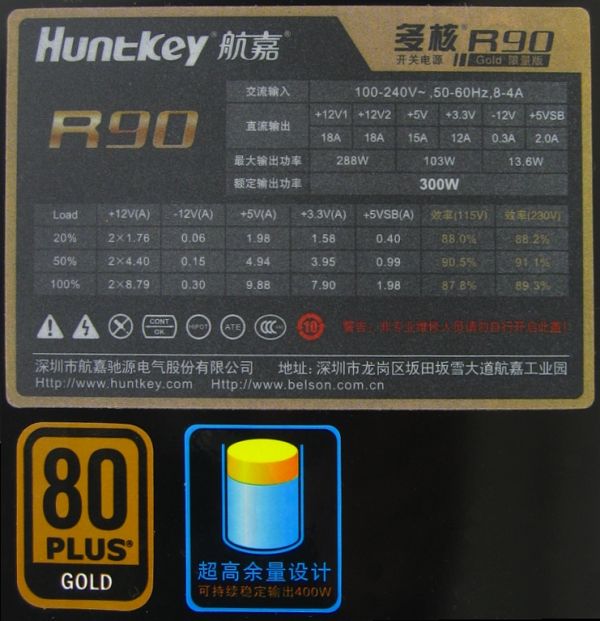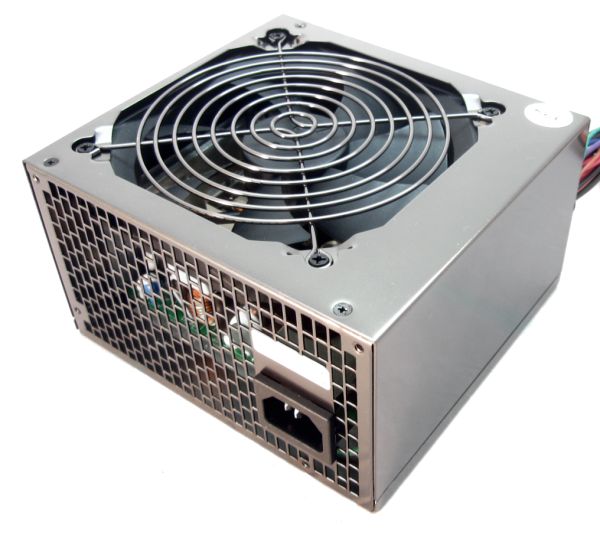HuntKey Jumper/R90 300W 80Plus Gold
by Martin Kaffei on March 5, 2011 12:00 AM ESTAppearance and Specifications
Our review sample came without retail packaging, so we'll jump straight to the design and appearance. Above is the R90, with large rectangular cutouts for the rear ventilation. That's a standard HuntKey trait, as opposed to the hexagon/honeycomb ventilation used on many other PSUs. The R90 has a matte black finish, transparent fan blades, and cable sleeving that could easily be mistaken for something from Enermax. It's a decent looking, understated design and the case is only 14cm long.
Given the 80 Plus Gold certification, the use of DC-to-RC VRMs should be too surprising, but it's not something we typically see in the 300W market. Most of the power comes on the two +12V rails and we tested OCP at room temperature. OCP kicked in at 28A, which is definitely more than you'd normally get from a 300W PSU. However, the smaller rails can deliver up to around 100W for peripheral hardware and HDDs/SSDs; that means in typical PCs you'll have less than 28A on the +12V rail to work with (like all DC-to-DC PSUs).
That should still be sufficient for running a moderate midrange or lower GPU. HuntKey informs us that up to a single GeForce GTX 260 or 460 (and maybe even a 560 Ti if your CPU isn't too extreme) should work; on the AMD side, that equates to a single Radeon HD 5850 or 6950 or lower (and you might even manage a 6970 if your CPU isn't too demanding). Then again, erring on the side of caution might not be a bad idea, in which case the HD 6850 and GTS 450 would be a more reasonable limit.
The Jumper 300G has a slightly different appearance. Gone is the matte black exterior, replaced by a shiny silver casing. The cable sleeving is also missing, and the fan grille is different. Internally, the units are the same, but the American market will be getting this rather vanilla looking version.













46 Comments
View All Comments
Beenthere - Saturday, March 5, 2011 - link
...then I would not touch their products for many reliability and ethical reasons.Taft12 - Saturday, March 5, 2011 - link
A near 0% failure rate among hundreds of PCs in my organization. These are Optiplexes with 80Plus certified PSUs stipulated in our contract. I wouldn't be surprised if some of these Huntkeys are in these machines.It's a different universe on the Inspiron side which you sound familiar with. Like most things in life, you get what you pay for.
JarredWalton - Saturday, March 5, 2011 - link
Yeah, Dell isn't without their problem computers in the business world (I supported some old GX150 systems back in 2003-2006 that had a bit of problem in the memory subsystem that would make Photoshop crash the PC all the time), but by and large the Optiplex and Latitude line is very reliable compared to consumer systems.clarkn0va - Monday, March 7, 2011 - link
I don't know. We have a handful of Latitudes here and every single one of them have serious IO issues. The Windows logon sound is choppy, the mouse pointer freezes constantly then plays instant catch-up; typing is the same. We've turned off the page file (4GB RAM, W7x64), tuned the hdd settings, tried readyboost--nothing fixes this.But we could compare anecdotes all day. The OP also mention ethical reason, and the public record for Dell's underhanded dealings is long and detailed. I too will be steering clear of everything Dell for a long time to come.
And now, back to your regularly scheduled discussion of Huntkey.
ckryan - Saturday, March 5, 2011 - link
I suppose the main reason capacity is an issue is due to the efficiency curve of a PSU. With loads optimized for 20, 50, and 100 percent, a 35w idle system is more inefficient with a higher capacity PSU. But not all PSUs have problems at less than 10%; the Seasonic X-650 is 88% efficient at a 60w load. The flip side is 35w idle system won't waste much even at an abysmal 70%. So while I welcome more reasonable options in the >500w watt space, especially excellent units like the Huntkey, I'm not sure dramatically over powered units are as huge of an issue as it used to be. Still, I think it's ridiculous that there aren't more 350 to 500 watt units that are of a high level in terms of efficiency and quality. I would certainly pay a premium for a higher end unit, regardless of capacity.We need more units like the HuntKey.
Scour - Saturday, March 5, 2011 - link
Peripheral 3x SATA + 1x PATA 45-90cm3x PATA + 1x SATA 45-90cm
In addition there are two peripheral cables with four SATA and four Molex connectors.
So what, did it have 6 SATA and 2 4-Pin or 4/4?
Overall, nice review of a nice PSU :)
Concillian - Saturday, March 5, 2011 - link
Even though I would have bought something like this instead of what I bought recently, traditionally low wattage high quality units have a really difficult time gaining traction. Sales are usually really slow on these kinds of units.Like it or not most people don't read reviews or know (or care) that PSUs are low efficiency at low load, and see that they can get a 550-650W 80+ gold unit for only a few bucks more and go for double the power for the headroom.
Also doesn't help that video card MFRs put PSU requirements that are totally absurd (HD5770 "requires" a 450W PSU... yeah, don't tell that to mine hooked up to a 380W PSU and running fine.)
Ultimately, making an 80+ gold PSU costs money and the unit will be expensive.
This seems to have efficiency at low load that rivals the PicoPSUs and is a lot less hassle and more headroom if someone's using a case that can accommodate a full size PSU. Probably not too much different in price from a Pico either. From that standpoint it's an interesting PSU. Lets hope it sells enough to keep a couple units like this on the market for a while.
Operandi - Saturday, March 5, 2011 - link
I think you are 100% right, Seasonic used to make a 330 watt S12, the lowest version available now is 380 watts.Even if they know their system will only draw 200 - 250 watts max the average buyer would rather have a 500 watt PSU of mediocre quality than a high quality 300 - 350 watt PSU. And most users don't have any real idea of how much power they need or are just going my what is recommended on the box which is always some crazy inflated number when you are talking about graphics cards.
As to the unit itself I prefer the played down looks of the American version. And it dose look like an awesome PSU but $90 is a lot when I can get an 300 watt 80+ OEM Seasonic for $40.
Zoomer - Sunday, March 6, 2011 - link
It will not be $90. Look out what other parts cost in Japan and you'll see. I guesstimate $50 or so.7Enigma - Monday, March 7, 2011 - link
Hope this was a joke post, because there is no way this will be below $80.